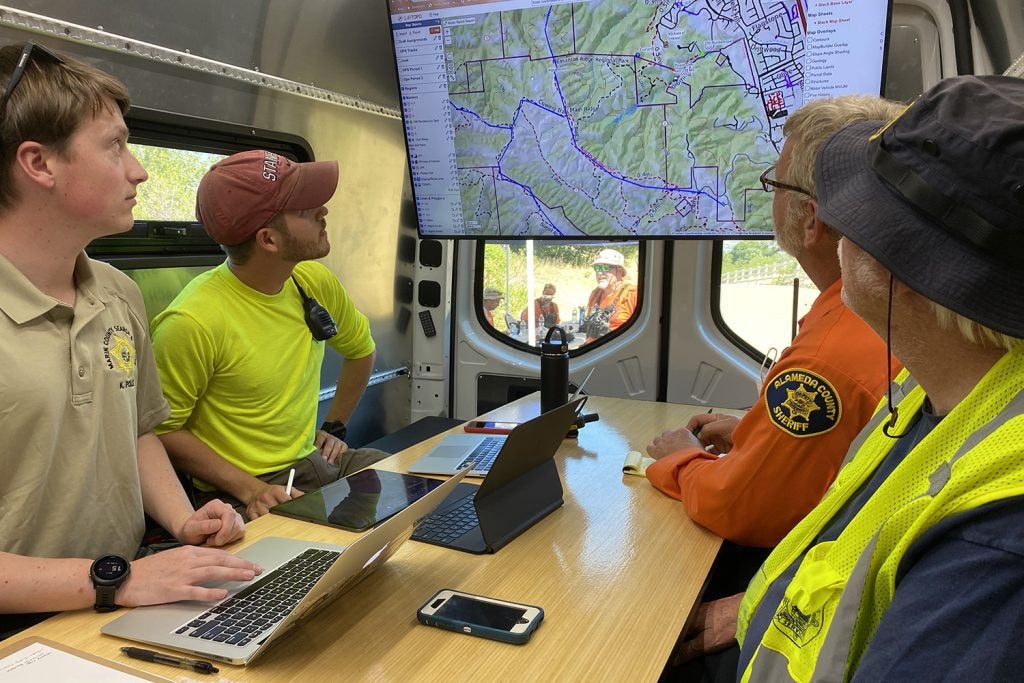Stanford student finds purpose in search and rescue work
Stanford public policy undergrad Liam Anderson has spent hundreds of hours over the last six years volunteering for the Marin County Search and Rescue Team. Last week, he served as plan section chief in the search for missing runner Philip Kreycik.
While growing up in Corte Madera, just north of San Francisco, Liam Anderson heard gripping stories from a family friend about search and rescue operations involving helicopter flights into backcountry mountains.

Liam Anderson addresses fire and law enforcement agencies as the plan section chief during the Philip Kreycik search operation in July 2021. (Image credit: Courtesy Liam Anderson)
Now, Anderson has his own stories to share as a member of the Marin County Sheriff’s Office Search and Rescue team. The Stanford public policy undergrad juggles the intense volunteer work with his studies as he enters his junior year. He also competes on Stanford’s track and cross-country teams and is co-president of the Student Athlete Advisory Committee.
Last week, Anderson was pulling 17- to 18-hour days while working as the plan section chief in the search for Philip Kreycik, a man who went missing July 10 after going for a run in Pleasanton, California. He has not yet been found.
“It’s such an incredible way to give back to the community and use skills and talents that I have that can be beneficial to others,” he said.
Anderson began his search and rescue training at age 14. The Marin County Search and Rescue Team is the only one in the nation that allows teenagers to be full members of a certified search and rescue team, said Michael St. John, team unit leader.
Over hundreds of hours, Anderson has trained in everything from emergency medicine to rope rescue to emergency management. He’s responded on numerous backcountry search-and-rescue missions across California, including highly complex ones that involved being flown in by helicopter.
“It’s one big learning process as you progress so you’re constantly learning and constantly evolving,” Anderson said. “It’s been six years of learning something new every day and putting that to use to help others.”
Anderson was in Nevada City teaching a search management class with St. John and others on July 11 when he received the call to respond to the Kreycik search.
“It’s rare that we get missing runners so that immediately piqued my interest,” he said.
The team left the class they were teaching early and headed straight to Pleasanton where they began drawing up operational plans.
“When we arrived, it was definitely a very busy incident,” Anderson said. “There was a strong sense of urgency.”
Nineteen agencies were involved in the operation.
St. John has a saying, “keep a positive sense of urgency,” Anderson said. “It’s a saying that I’ve really bought into. … It’s to keep moving in an expedient and urgent manner while being calm and collected in what you’re doing.”
Anderson helped by coordinating multiple large search teams, deciding which resources were most appropriate for the task, reevaluating search scenarios, speaking with the media as a subject matter expert and assisting with briefing the missing man’s family on operations.

Liam Anderson (second from left) speaks with other members of a search and rescue team during the Philip Kreycik search operation in July 2021. (Image credit: Michael St. John)
“One thing Stanford teaches you really well is how to work with people from all types of backgrounds. And that’s something that’s always applicable on a search when working with fire and law enforcement agencies from across the state while also liaisoning with a missing person’s family and other stakeholders,” he said.
Chris Young is a member of the Contra Costa County Search and Rescue Team and chairman of the Bay Area Search and Rescue Council, which encompasses 20 SAR units in the greater Bay Area. He worked with Anderson on the search in Pleasanton.
“It’s admirable,” he said. “For me, I’ve been doing this almost 40 years. I love to see the younger people with the energy and a different perspective. … That’s what is heartwarming for me, to watch those people, the up-and-comers.”
He said this search was unique in that there was a large convergent volunteer search effort made up of family, friends and runners. The operation was able to electronically track where the civilian volunteers were searching, along with where the trained volunteers were searching, and overlay that into SARTopo mapping software to determine where had been covered.
Anderson used the data as part of planning operations.
A runner himself, he also went into the search area to follow the missing man’s believed route of travel to obtain insight that may assist search planning. He also thought to tap into a popular running app to get a sense of the man’s strength and capabilities.
Anderson has strong leadership and interpersonal communication skills that allow him to effectively take on complex organizational tasks required in searches, St. John said.
“Liam is very resilient and can handle a lot of pressure because he knows what’s at stake,” St. John said. “It takes a special person to do that. … He has a very good way with family and people. He’s very humble but also very truthful and patient because they have tons and tons of questions.”
What’s most important for Anderson is “feeling like I’m able to make a difference in the lives of others, especially at a time when people are undergoing such hardship and searching for a loved one,” he said. “There’s no greater feeling than saving somebody’s life when they’re most in need. And that’s something that search and rescue has given me the incredible opportunity to do.”